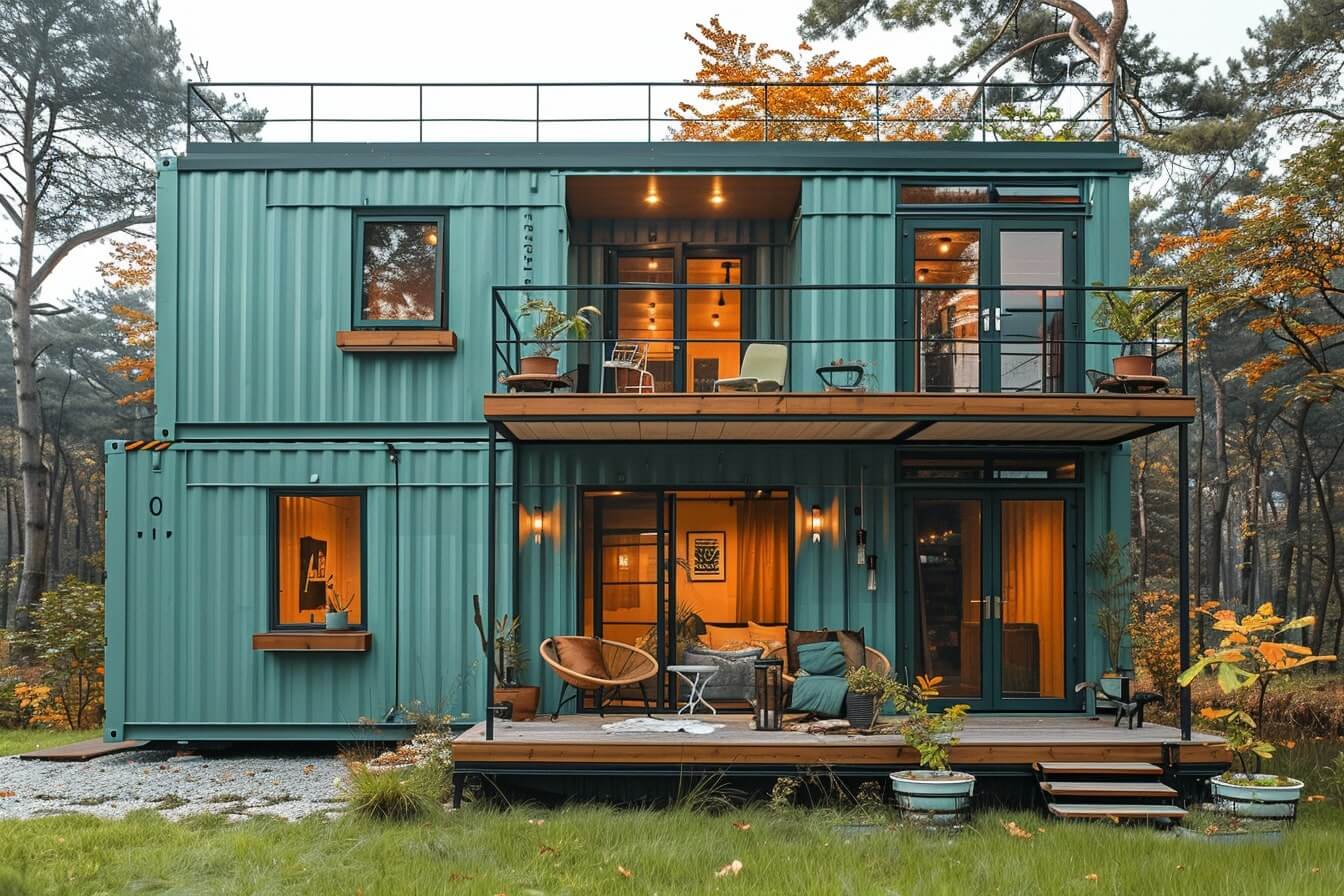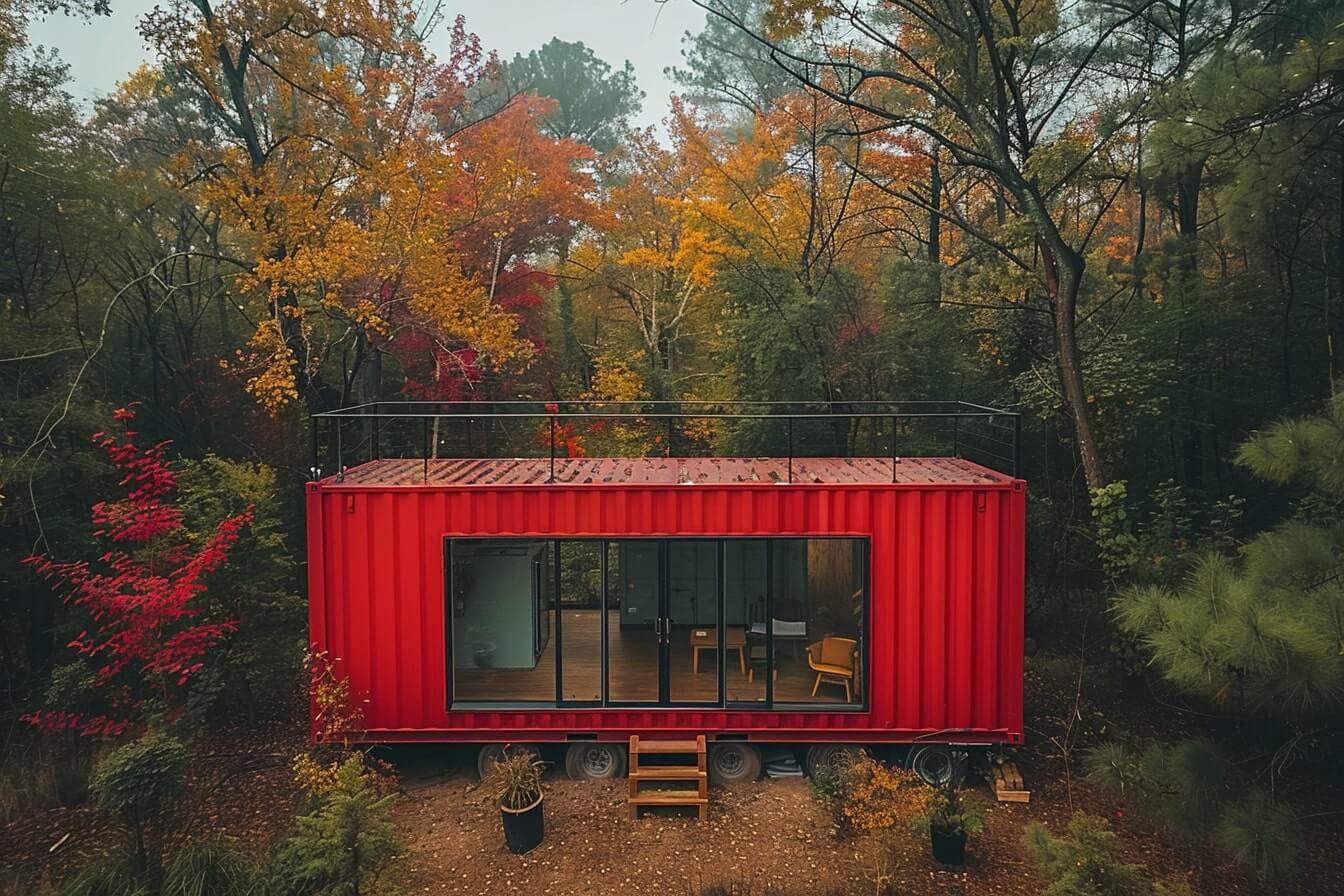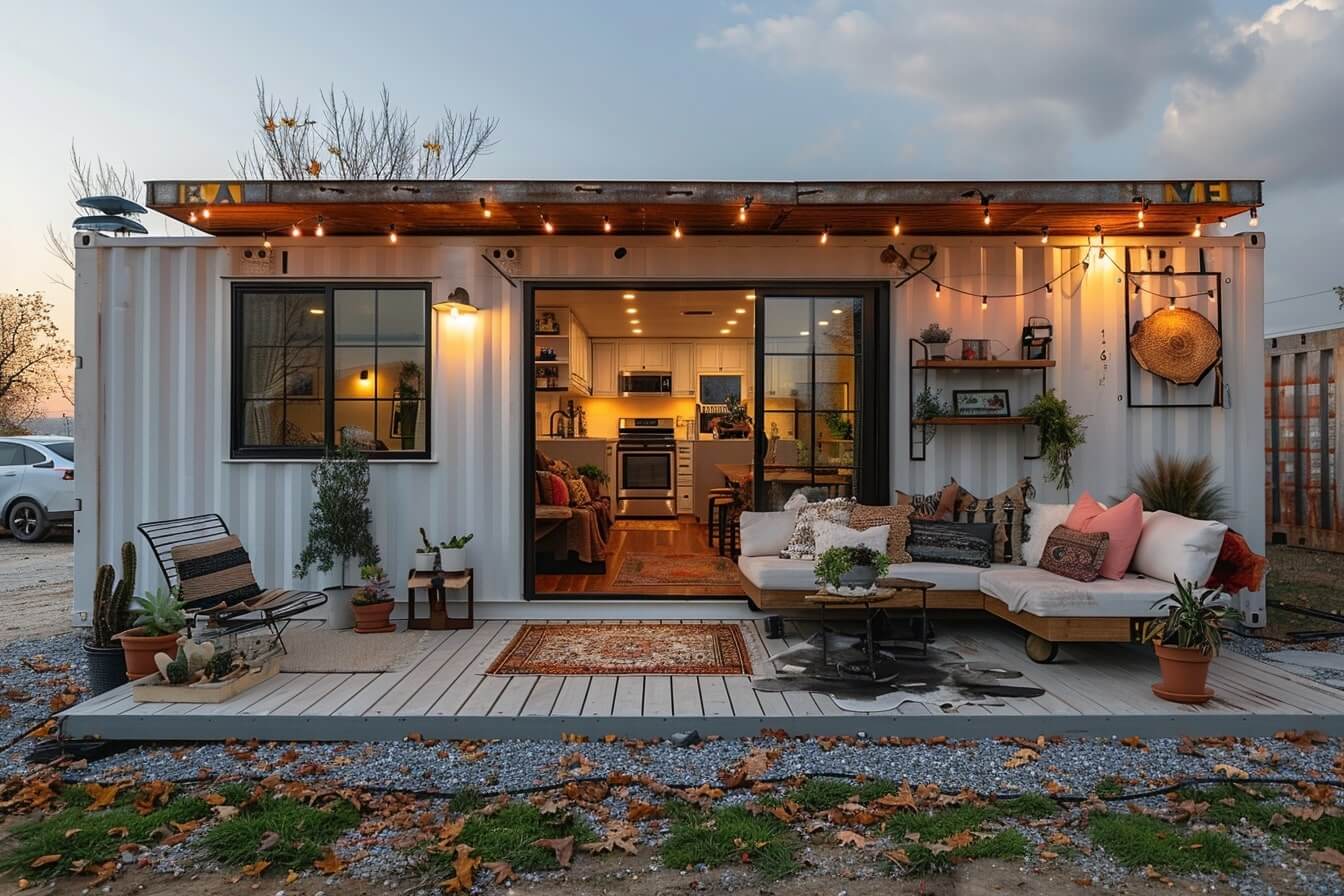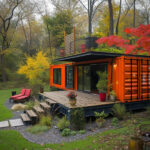Shipping container living has emerged as an innovative housing trend for those seeking an alternative to traditional home structures. These steel containers, originally designed for transporting goods across vast distances, now find new purpose in the architecture world. The relatively low cost, durability, and modular nature of shipping containers make them an appealing option for constructing homes that range from simple, small dwellings to elaborate, multi-story residences.

As the need for sustainable and affordable housing increases, shipping container homes have gained attention for their potential to repurpose existing materials in environmentally friendly ways. Incorporating techniques such as protective coatings can effectively prevent rust, ensuring the longevity of these structures. Adaptable to various lifestyles and locations, they offer opportunities for compact living without compromising on modern necessities.
With their standardized dimensions — typically 20 feet by 8 feet or 40 feet by 8 feet — container homes present a unique architectural challenge. Designers and homeowners often combine multiple containers to create larger floor plans, displaying the versatility of these steel units. Shipping container homes encapsulate a form of innovative magic, merging eco-friendly philosophies with the desire for a unique living space.
Basics of Shipping Container Living

Shipping container living involves repurposing steel containers originally designed for cargo transport into habitable spaces. They offer a distinctive blend of durability and adaptability, appealing to those seeking sustainable and eco-friendly housing options.
Understanding Shipping Containers
Shipping containers are robust, steel boxes designed to withstand the rigors of long-distance, international shipping. Their strength and ability to protect contents from harsh weather make them suitable for conversion into container homes. The containers come primarily in two standard sizes: 20 feet by 8 feet and 40 feet by 8 feet, providing a compact framework for architectural transformation.
Advantages of Container Homes
Container homes boast durability, a direct result of their original purpose to endure ocean travel. They offer eco-friendly living solutions by repurposing otherwise unused containers. These homes can also be significantly more affordable and faster to construct than traditional housing, as much of the structure is already built.
Types and Sizes of Containers
The most common types of shipping containers used for homes are the 20-foot and 40-foot lengths, both with a standard width of 8 feet. The standard 20-foot container provides about 160 square feet of space, while the 40-foot options offer around 320 square feet. High cube containers are another option, providing additional height for more vertical living space.
Sustainability and Eco-Friendliness
The re-use of shipping containers for housing aligns with sustainable practices by reducing the need for new construction materials and minimizing waste. When outfitted with insulation, solar panels, and other green technologies, container homes can become models of eco-friendly living. They serve as a testament to innovative, environmentally conscious architecture.
Design and Customization

In shipping container living, the ability to tailor a home to one’s specific needs is central to its appeal. Homeowners can choose from various customization options to create a unique and functional living space.
Customization Options
Shipping container homes offer a unique opportunity for customization. Individuals can customize elements such as insulation, interior finishes, and even the type of doors and windows. They have the flexibility to add custom features like built-in furniture or sustainable elements such as solar panels. For example, companies like Custom Container Living offer homes ranging from basic to luxurious, with a wide array of custom options to suit different budgets and preferences.
Choosing the Right Floor Plan
Selecting the right floor plan is crucial in shipping container living. A good floor plan maximizes space usage, creating an efficient and livable interior. Potential homeowners should consider the number of rooms needed, the desired layout, and the flow between different areas. It is beneficial to explore various floor plans—from simple one-bedroom layouts to more complex designs—to find one that aligns with one’s lifestyle. Dwell and Container Addict offer a range of shipping container home floor plans that maximize space and can be adapted to specific requirements.
The Role of Architects in Custom Container Living
Architects play a pivotal role in custom container living, bringing technical expertise to the realization of a client’s vision. They ensure that the layout and interior design adhere to building codes and sustainability standards while still achieving aesthetic goals. Architects can also provide innovative solutions to challenges specific to shipping container homes, such as climate control and space optimization. Services like Kubed Living specialize in shipping container and modular structures, often employing architects to create cutting-edge designs.
Building Process

Building a shipping container home involves several steps that are critical to the project’s success, including obtaining legal clearances, preparing the site, and choosing between professional or DIY construction approaches.
Obtaining Permits and Approvals
Permits: They are a non-negotiable aspect of the building process. One must navigate through local zoning regulations, building codes, and possible homeowners’ association rules to acquire the necessary approval for construction. Completing this step before any construction begins can help avoid legal complications and ensures compliance with all regulatory requirements.
Approvals: Besides the general building permits, special approvals may be required depending on the project’s scope, such as environmental assessments or septic system permits. Engaging with local authorities early on can streamline this process.
Preparing the Foundation and Site
Foundations: A solid foundation is essential for any construction, but especially for a shipping container home. The types of foundations suitable for such a home typically include pier, pile, slab, and strip. The choice depends on soil composition, climate, and container home design. Proper site preparation involves clearing the land, grading for drainage, and installation of the selected foundation type.
Site Preparation: This critical phase impacts the longevity and stability of the container home. One must ensure the site is accessible for delivery trucks and cranes, as foundations for shipping container homes require precision in alignment.
Selecting Contractors and DIY Options
Contractor Selection: For those with less experience in construction, hiring a reputable contractor with a portfolio in container home building is advisable. A competent contractor ensures structural integrity, proper insulation, and efficient electrical and plumbing system installation.
DIY Container Home: Conversely, individuals with construction expertise might opt for a DIY approach. This can reduce costs significantly, but one should thoroughly research, understand all steps involved, and be prepared to manage every detail of the process from design to finishing touches.
Living Comforts and Amenities

Living in a shipping container home does not mean sacrificing the comforts and amenities of traditional housing. Proper solutions for temperature control, access to utilities, and personalized customization are key to ensuring a comfortable living environment.
Insulation for Temperature Control
Insulation is a critical component for maintaining a comfortable living space within a shipping container home. Adequate insulation helps to manage the internal temperature, keeping it warm in winter and cool in summer. Common insulation materials include:
- Spray foam
- Panel insulation
- Blanket insulation
Each type has its own advantages in terms of R-value (resistance to heat flow), and choice often depends on the climate and individual preference.
Electricity, Plumbing and Fixtures
Shipping container homes can be fully equipped with electricity and plumbing to offer all the modern conveniences expected in a household. This includes standard wiring for lighting and appliances, as well as plumbing systems for functional bathrooms and kitchens. When installing:
- Electricity: Use a licensed electrician to adhere to building codes and safety standards.
- Plumbing: Incorporate efficient water heaters and low-flow fixtures to maximize water usage.
It’s imperative for homeowners to plan for these systems early in the design process to integrate them seamlessly into the layout.
Benefits of Customization in Comfort
The uniform structure of shipping containers lends itself to customization. Homeowners can design their living spaces to fit their unique needs and comfort preferences, which may include:
- Appliances: Selecting energy-efficient and space-saving models.
- Fixtures: Tailoring style and function to personal taste, such as choosing ergonomic faucets or luxurious shower heads.
Such customizations not only enhance comfort but also reflect the homeowner’s personality, making each shipping container home distinct and personalized.
Cost and Affordability

The cost of living in a shipping container home is influenced by various factors, including the price of containers, construction expenses, and customization. This section discusses how potential homeowners can budget effectively, implement cost-saving strategies, and consider financing options for an economical investment in a container home.
Budgeting for a Container Home
When planning a shipping container home, it is crucial to understand that costs can range significantly. An average single-container home may cost between $25,000 to $80,000, while larger, multi-container homes might range from $80,000 to over $250,000. Construction costs usually lie at about $150 to $350 per square foot.
- Single-Container Home
- Low-End Estimate: $25,000
- High-End Estimate: $80,000
- Multi-Container Home
- Low-End Estimate: $80,000
- High-End Estimate: $250,000+
Custom options greatly influence the bottom line, so a detailed budget plan should include every aspect from purchase to finish.
Cost-Saving Tips and Ideas
There are several ways to make the construction of container homes more cost-effective. Purchasing a used shipping container can be an affordable option, with prices for a decent-quality unit ranging between $1,500 and $5,000. To further reduce expenses, prospective homeowners can:
- Choose economical finishes and fixtures.
- Employ a minimalistic design to decrease the need for extensive modifications.
- Use DIY efforts for appropriate tasks to cut labor costs.
Financing and Investment Considerations
Financing a shipping container home can be challenging as it is a relatively new concept for many lenders. However, with the growing popularity, more banks are beginning to offer loans for these types of homes. Investments in energy-efficient and sustainable features can make these homes eligible for specialized green financing options, which might prove to be more economical in the long term.
- Green Loans: Potentially lower interest rates for energy-efficient homes.
- Personal Loans: Flexible options for smaller-scale projects.
- Construction Loans: Structured for phased disbursement during the build process.
Affordability largely depends on strategic financial planning and a willingness to seek out and negotiate optimal financing solutions.
Regulations and Compliance

Adhering to regulations and ensuring compliance is crucial for those considering container living. These standards safeguard safety, quality, and structural strength, maintaining the integrity of shipping container homes.
Understanding Building Codes
Building codes are the foundation of constructing a shipping container home. They determine the structural requirements that ensure the strength and durability of the construction. For instance, living in a container requires understanding how local standards affect design and construction. Compliance with these standards is non-negotiable for legal and safety concerns.
Navigating Zoning Regulations and Restrictions
Residents must navigate zoning regulations that dictate land use and building placement. Zoning regulations can vary greatly and typically address location constraints, building size, and land usage. It’s essential for individuals to familiarize themselves with their local zoning restrictions to determine if shipping container homes are permissible and under what conditions.
Safety and Quality Standards
The construction of shipping container homes must prioritize safety and adhere to quality standards. Homeowners must consider potential chemical hazards, ensure fire safety, and uphold the container’s structural integrity. Meeting these standards is essential for creating a secure living environment and complying with the International Building Code, which outlines the necessary safety measures for alternate structures like shipping container homes.
Challenges and Solutions

While shipping container homes offer innovative living solutions, they come with a set of challenges related to weather, moisture, and space. By recognizing these issues, one can apply practical strategies to transform these robust structures into comfortable and sustainable living environments.
Dealing with Weather and Environmental Challenges
Steel shipping containers are inherently strong, but modifications can affect their structural integrity. In areas prone to extreme weather conditions like hurricanes, reinforcing containers with additional structural supports is crucial. Adequate shelter development to withstand earthquakes plays a significant role in maintaining the safety and stability of container homes.
Managing Moisture and Preventing Mold
Containers are metal boxes that can condense moisture if not insulated properly, leading to a risk of mold. To counteract this, one must ensure proper insulation to maintain a consistent internal temperature and circumvent condensation. Moreover, allowing for sufficient ventilation and installing moisture barriers are key in protecting against mold growth.
Overcoming Space Limitations
The compact nature of container homes requires smart design to maximize space. Creative solutions include stackable or expandable containers, multifunctional furniture, and decluttering habits. Having an efficient layout and embracing minimalistic living are vital steps to make these spaces feel more open and livable.
Real-Life Examples and Case Studies

Exploring real-life examples and case studies provides tangible insights into the practicalities and innovations within the realm of shipping container homes. These stories illustrate the diverse applications and the people who have embraced this style of living.
Profiles of Successful Container Homes
Honomobo Homes
Honomobo stands out as a leader in integrating modern design with container-based construction. They offer a range of sizes and layouts, from tiny homes to larger family residences, showcasing versatility. For example, a Honomobo tiny home may start as a single container structure but can be expanded through modular design, exemplifying scalability and customization.
Backcountry Containers
Founded by Robert Wagoner, Backcountry Containers crafts bespoke container homes that fit into various landscapes. Each home is designed with the client’s needs in mind, from a tiny house retreat to a full-time family home. These container homes are not just functional; they also boast a sense of style that challenges conventional architecture.
Interviews with Container Home Residents
Living in a Compact Space
Residents of shipping container homes often appreciate the efficient use of space associated with their tiny home. In interviews, they frequently express satisfaction with the minimalistic lifestyle that a container home affords them, emphasizing the freedom from unnecessary possessions and financial burdens.
Embracing Community and Sustainability
Many families choose shipping container homes for their potential environmental benefits. Interviews reveal a common theme of community among residents, where sharing surplus space or utilities is typical. People also highlight the homes’ sustainability, noting the recycled materials used in construction and their often off-grid capabilities.
Additional Considerations

When considering shipping container homes, potential owners should pay close attention to the details that affect livability and long-term satisfaction. These considerations include the selection and installation of accessories, ongoing maintenance requirements, and the trends that could impact the home’s future market value.
Accessories and Add-Ons
Shipping container homes offer a versatile canvas for various accessories and add-ons. Homeowners often install custom windows and doors to enhance natural light and improve accessibility. The choice of cabinets and finishings in the kitchen area can greatly influence both function and style. For those renting out their container homes, adding high-quality accessories can potentially increase the rental value.
Maintenance and Upkeep
The maintenance of a shipping container home is uniquely distinct from that of traditional homes. Siding, often made from the original container material, requires inspections for rust and weathering. Regular upkeep such as applying protective coatings can greatly extend the life of recycled shipping containers. It’s important that owners address any breaches in the container’s integrity that could lead to leaks or insulation issues.
Resale Value and Market Trends
The resale value of container homes can be influenced by various market trends, including the growing popularity of minimalist and eco-friendly living. Homes with high-quality finishings and cleverly designed kitchens and bathrooms tend to retain their value better. However, it’s vital to recognize that the market for container homes is less established, which can affect liquidity when selling.
By carefully considering these aspects, individuals can better navigate the unique challenges and benefits that come with a container home.
Conclusion

Shipping container homes have emerged as a significant alternative living space that most commonly appeal for their sustainability and affordability compared to traditional homes. They offer a unique solution to sustainable living by repurposing disused containers, thus saving natural resources and reducing the environmental impact of new construction.
Advantages:
- Affordability: They can be far less costly than traditional housing.
- Sustainability: Their use recycles existing materials and often has a smaller carbon footprint.
- Portability: These structures can be easily moved to different locations, which is not the case with conventional homes.
Challenges:
- Space: Container homes have limited space, which may necessitate efficient design and organization.
- Regulations: They must adhere to local building codes and zoning regulations, which can vary widely.
Individuals seeking alternative living spaces that are both economical and environmentally conscious might find container homes a fitting choice. It is, however, essential for potential dwellers to consider the practicalities of such a lifestyle, including spatial constraints and the need for customization to ensure safety and comfort.
Adopting container homes as a living solution can significantly contribute to the movement towards environmentally responsible living by minimizing reliance on new construction materials. Yet, it remains necessary to approach this living option with a realistic understanding of the benefits and limitations it presents.










